Tung Ping Chau is set in the east of Mirs Bay.
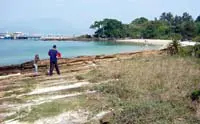
One of the more ridiculous Hong Kong Government announcements had a conversation between a wife and her stressed husband; she suggesting he take “a holiday to the Internet”. Far better – assuming they’re staying within Hong Kong – would be to head to the islet of Tung Ping Chau (東平洲), which is pretty much the furthest you can get from the city without needing your passport.
Tung Ping Chau is set in the east of Mirs Bay, too distant for most Hong Kong maps to show it properly (it may appear in an inset box, off the northeast New Territories). Unless you own or rent a boat, the journey there is by a 1.5-hour ferry ride, with ferries only on weekends and public holidays.
Though only 2km long, and relatively flat (rising to just 48 metres), Tung Ping Chau makes for a cracking – and relaxing – day out, or even overnight stay. There’s a fine beach, with coral heads just offshore; hamlets dot the island, some of them intact, others in ruins; trails wind through the hamlets and old woods and fields, and skirt the top of cliffs.

Tung Ping Chau (the “Tung” – “East” – helping distinguish it from Peng Chau near Lantau, western HK) is shaped like a crescent moon, cradling a sandy beach along the east coast, and with low cliffs to the west and south. Unaffected by the Pearl River that muddies the waters off west Hong Kong, the sea here is relatively clean – it’s typically tropical blue.
This is one of Hong Kong’s premier sites for coral, and coral heads grow in the shallow waters; the sea here is typically tropical blue, and especially if the tide is low, you may see coral heads as you walk along the ferry pier, maybe with shoals of small fish in attendance.
Trails on Tung Ping Chau
There are several trails, the main one making a circuit of Tung Ping Chau, with small side trails you can explore – these don’t always really go anywhere, but you can find yourself in small woods that are partly hiding ruined hamlets.
If you’ve arrived on a busy day, you may find these trails useful for avoiding the crowds (most will leave late morning, or by early afternoon); and if you’re a birdwatcher, these woods are well worth searching for migrants: especially in spring, when they can hold spectacular flycatchers like Narcissus, Japanese paradise, and blue-and-white.
Only few houses are still maintained on Tung Ping Chau, chiefly in hamlets just north and south of the ferry pier. They’re not for people who stay year-round: most residents moved out some years ago, but may return to open their old homes as hostels and restaurants that cater to holidaymakers from urban Hong Kong.
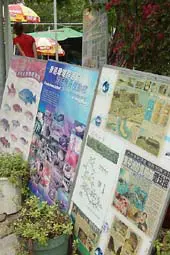
When I first went to Tung Ping Chau, in the early 90s I think, it seemed to be a place that relatively few people visited. But lately, with the boom in “eco-tourism” in Hong Kong (spurred by SARS, which prompted people to head out for fresh air), it’s become a hot destination for Hongkongers. To my eyes, the boom is pretty chaotic, but it does seem good that the restaurants are thriving, and now have boards up with pictures of fish and other marine life – providing, that is, there isn’t an onslaught on these creatures.
Walking anti-clockwise around the island, you’ll soon pass a sign just above the tideline, noting that the area just offshore is a coral protection zone, with marker buoys indicating where mooring is banned. The Tung Ping Chau Marine Park surrounds the island; though with recreational fishing permitted in some areas, and (when I’ve been) perhaps no control on people collecting creatures in rock pools, it’s surely far from perfect.
The land, too, is protected in the Plover Cove Extension Country Park, and as you continue on round, you’ll find that the old fields where crops were once raised, cattle reared, are thoroughly overgrown, with scrub soon to give rise to young woods.
Part-way down the west coast is Cham Keng Chau, a dollop of land which the sea has almost sliced away from Ping Chau.
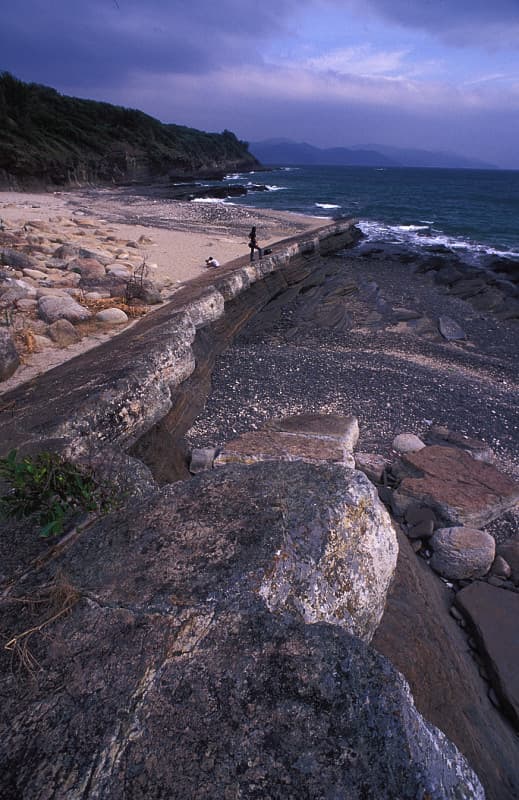
Also, Lung Lok Shui – Dragon Descending to the Water, formed from a hard band of chert that resists erosion more than the layers of mudstone above and below it. The island’s mudstone is unique in Hong Kong, and is the youngest local rock formation – leading to Tung Ping Chau being included in the Hong Kong Geopark.
The cliffs rise as you head south, though hardly enough to make you dizzy. Then, the trail drops down, to the southeast tip of Tung Ping Chau. Here, a couple of house-sized stacks preside over rock pools amidst layers of mudstone.
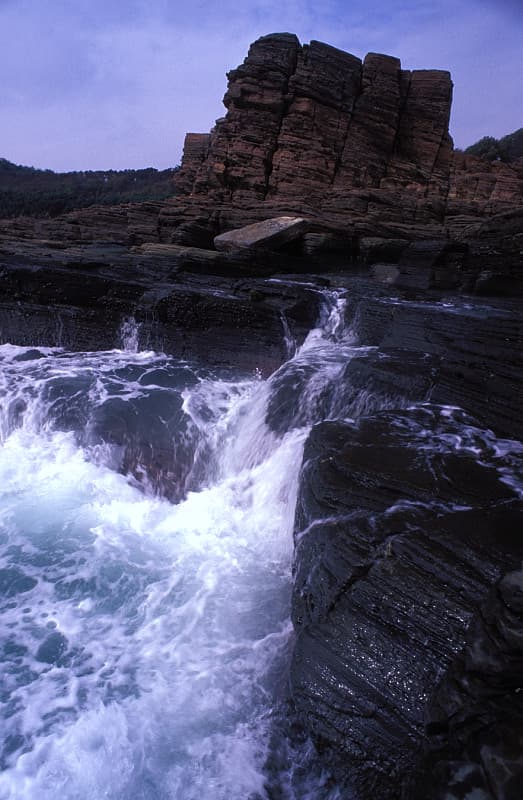
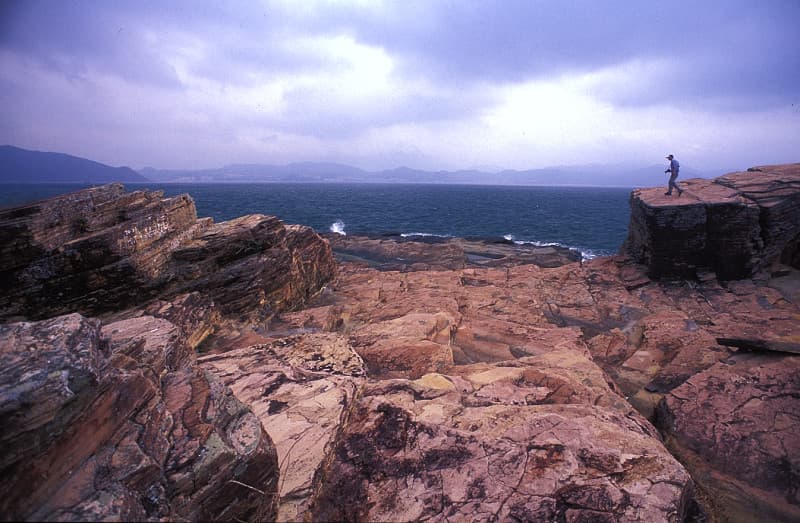
This is a popular place with visitors – I guess best avoided soon after the morning flotilla of ferries arrives – and though you can find fish and other life in the rock pools, it could be that there’s way too much uncontrolled collecting of crabs, urchins and so on.
 Once when I visited, there were five rather splendid, green nudibranchs (sea slugs) grazing in one pool. Another pool held three fabulously colourful fish, which someone had caught, and released there (they’d be freed by the high tide).
Once when I visited, there were five rather splendid, green nudibranchs (sea slugs) grazing in one pool. Another pool held three fabulously colourful fish, which someone had caught, and released there (they’d be freed by the high tide).
But we also found no urchins, and no crabs – just seeing fragments of crab shells in a pool.
It was, though, real pleasant being there in the late afternoon, when all but a handful of people had gone.
And, it was time to dash off – as our return ferry was set to depart shortly.
The Tsui Wah Ferry Service operates ferries to Tung Ping Chau, departing Ma Liu Shui (near University KCR station) on Saturdays, Sundays and public holidays.
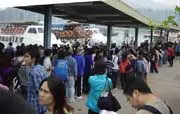
Be warned that, especially with “eco-tours” (hmm….) for Hongkongers booming, the two small piers at Ma Liu Shui can be festooned with people before the morning ferry departure times – it seems all boats aim to leave around 9am.
You may even find you have to spend some time queuing for your ticket (or buy in advance?); I reckon it’s well worth putting up with the hassle.
















Chau tau
I hate chau tau…way too many ants
Tung Ping Chau and the ants
I think you mean Tung Ping Chau; but yeah, in last two or three years, overrun with ants – though it seems not all island affected, main concentrations being near marine police station in north. Darn nuisance: inc as bite.
Something weird w ecology; I’ve been meaning to email someone to ask re this, including re whether some ant predator [or parasite?] is missing; will do so now.
tung ping chau
it’s a [*&^% deleted] crappy place to visit..so my advice is not to go there and [*!* deleted] up somewhere…………
[edited by Martin – don’t really need typos n profanities, ta very muchly. Now, please go and wash your mouth out with soap and water ]
Tung Ping Chau ants
I did have email discussion re Tung Ping Chau ants (inc sending a photo I’d taken), chiefly w biologists based at Kadoorie Farm.
Replies included this from John Fellowes:
[quote]These do look like Polyrhachis dives, the native so-called "black tree ant" (though it’s not black and isn’t often found on trees – nests more on shrubs). It’s usually in abandoned farmland – highest numbers I’ve seen were at Mai Po where the ant community is very odd because of the reclaimed soil (and where invasive ants also prosper), and Sha Lo Tung where inundation made life difficult for other ants. Hard to explain the infestation without going there but factors to consider: what are they feeding on? Must be an abundant food source – presumably either plants (via aphids/scale insects or nectaries) or rubbish? Meanwhile they don’t do well in a diverse ant community – perhaps there’s a lack of ant predators/competitors. Any toads on the island? (I wouldn’t advocate introducing them, or anything else, without a thorough ecological impact assessment).[/quote]
– a reptile and amphibian survey failed to find toads; so may well be there’s lack of predators for these ants.
Do you think there’s other serivce provider besides tsui wah?
Just wondered if there’s any other service providers besides Tsui Wah Ferry Service, we would love to bring our dogs to Ping Chau. Duno if we can get on their ferry?
tung ping chau ferries and dogs
Don’t think there’s a ferry service by another company; though do get some tour boats (can be pretty packed, and seem to be quick visits) going to Tung Ping Chau too.
Maybe phone/email Tsui Wah re dogs: I’ve hazy memory of seeing dog on return ferry last time I went.
Ferries
Where do you get on? I know it’s near the China University of Hong Kong, but where exactly?
Ma Liu Shui pier location
Basically, head from station towards the coast; there’s path, and likely to be others going that way.
From station, sea side, there’s path leading left, then up and over highway. Follow this. Down, and left; thro small underpass, and then there’s a rather badly designed area of paths, roads, pedestrian subway, on reclaimed land. You could head for a pedestrian subway, and turn left after this; pass toilet block and to pier on righ: you should see small ferries there, and people waiting on the pier.
Around 10 mins from station.
Might be useful to arrive early; at times I’ve known tickets sell out (thses days, if really busy, maybe a second ferry??)
reaching ferry pier.
Gosh Martin, the route to the pier sounds daunting to a first time visitor to HK. If we ask at the hotel, would they be able to get us straight there, avoiding this obstacle course? How many trips does Tsui Wah Ferry Services have in the day? What if we miss the 9 am ride? Cheers, Susy. susy_qin at yahoo.co.uk
to Ma Liu Shui pier
Hi Suzie:
Well, it’s a lot easier in practice than I made it sound! Esp as others head the same way.
Should be possible to get taxi to the pier
Just the one ferry, really (on Saturdays I think there’s a 3.30pm, which ok if to stay overnight)
Martin
getting to Ma Ma Liu Shui
There is a green mini bus from the bus terminus at Sha Tin MTR Station as well, to directly in front of the ferry pier…much easier than negotiating the maze of underpasses and poorly marked sidewalks, but as mentioned, you will likely be following a crowd to the gferry pier anyway, at least on Sat morn at 9…
buying property
is it possible to buy land here on ping chau?
…..
why would you want to buy land there? This is one of the few areas of Hong Kong that remains undeveloped…for good reason. Yuppies and their stupid ideas.
The ants were a nightmare!
I went camping on Ping Chau’s camping spot – which incidently is an over grown, litter infested, stinking hole, so don’t go – and the ants were an utter nightmare! I had to create a ring of mosquito repellent around the bottom of the tent just to stop them. I’ve been camping for years and never encountered anything like this before. I would not recommend camping here.
nightmare ants
The campsite used to look ok; but damaged by storm surge from Typhoon Hagupit last autumn, and evidently not looked after since.
I’ll pass message re the ants to Agriculture, Fisheries and Conservation Dept – tho I have already mentioned the problem, suggested trying "importing" toads from elsewhere in HK, but no feedback yet.
AFCD response re Tung Ping Chau campsite and ants
I’ve received this from AFCD:
[quote]Thank you for your information about the conditions of the Tung Ping Chau campsite, I will look into the case and arrange appropriate actions to improve the conditions of the campsite. Regarding the black ant, we were also aware that this native species could be easily found throughout the island. We consider that to keep the island clean and tidy is the basic works what we could do to control their population. For areas within country parks, we will continue to arrange staff to conduct cleansing works. For areas outside country parks, we have informed relevant departments about the issue and asked for their further actions.
According to our record, we noted that at least two amphibian species, i.e. Kaloula pulchra pulchra and Microhyla omata, were found on the island. Both species are predators of ants, termites and small insects. Therefore, it is hard for us to say that there is a lack of ant predators on the island and to introduce common toad to the island.[/quote]
I’ve replied:
[quote]It’s not just that the ants are easily found; they swarm in some areas, and readily run onto feet and legs and start biting.
Surely a nuisance to native wildlife [even killing and eating various species?], not just human visitors; and helping show this is an unbalanced ecosystem.
I’ve met people who talked re cleaning work; but issue surely isn’t litter, food being left – as that’s commonplace where there are visitors in busy country parks, and various places get visitors all days of the week.
I’ve been visiting Tung PIng Chau over around two decades; the ants only an issue in last few years. Increasing amounts of shrubland/woodland, as transition from intensive farming; yet not a good ecosystem.
Ideally, should be ecological assessment; also something re to what extent the amphibians you mention will feed on black ants, compared to other predators that may be common in Hong Kong, yet are not present on the island.
Something’s wrong; hope the problem can be identified, and solution found.[/quote]
Ants
I was there over the weekend, and was hoping to cut through the woods from the pier-side to the Lung Lok Shui cliff-side. We ended up taking the wrong path (2 dead ends at ruins just north of the little restaurants) but even then the path was nearly impassable as it was swarmed with ants about 10 metres out of the village. Wearing flip-flops made it even worse since they kept biting… so we had to high-step while running… not pleasant at all. We then went south, near the temple, to try to get around that way but, due to our earlier experience on the path, turned around once the ants started appearing in numbers (not as many as the path) again. Seems quite out of control, but somehow they don’t go into the villages at all.
Ants and Tung Ping Chau path
Sad the ants should spoil visit like this; I’ve forwarded this in email to AFCD.
There’s a path across the island from alongside the marine police post, north of the pier.
Path from village to south – near the temple – leads up past a small, often dry reservoir, thro a hamlet, and to west coast.
I suspect the ants don’t go into villages as pesticides applied to paths and other places around the villages (at least, the villages where people come back at weekends to open small restaurants etc). Another reason the ants can’t be good for overall ecology of Tung Ping Chau.